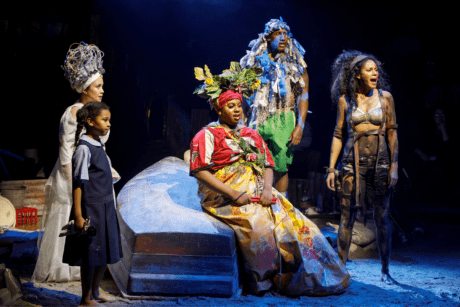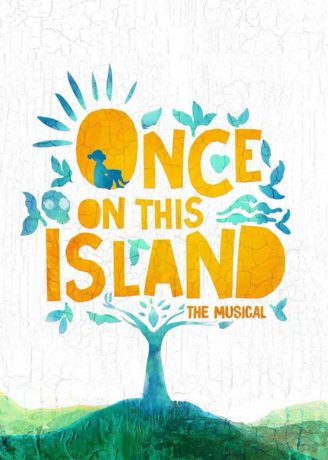The first Broadway revival of the 1990 Tony-nominated hit musical Once On This Island, with book and lyrics by Lynn Ahrens and music by Stephen Flaherty, brings an innovative vision to an old favorite. Under the vibrant direction of Michael Arden, the current production at the Circle in the Square Theatre, produced by Ken Davenport and Hunter Arnold, is given new life with a novel design and staging that immerse us in the captivating world of the eponymous island locale, expressive orchestrations and choreography that honor the authentic heritage of Caribbean culture, and unconventional casting that speaks to our present times. It’s a winning combination.
Based on the 1985 novel My Love, My Love: or The Peasant Girl – Trinidad-born author Rosa Guy’s tropical reimagining of Hans Christian Andersen’s popular fairytale The Little Mermaid (1837) – the mostly sung-through one-act narrative employs the format of a story-within-a-story, in which a close-knit community of villagers recounts the legend of Ti Moune to a little girl frightened by a severe storm ravaging their island. In so doing, the show pays homage to the time-honored tradition of storytelling to preserve history, to keep native culture alive for posterity, and to teach indigenous beliefs, rituals, and moral values to the next generation of children – while, here, also entertaining and enlightening theater-goers.

According to the fictional tale, the courageous Ti Moune (who, as a child, was saved by the gods from a deadly storm that killed her parents and many of the other “black as night” peasants on their poor half of the island) falls in love with Daniel, a wealthy light-skinned “grand homme” whom she rescues from a terrible car crash and heals, after offering the gods her life in exchange for his. But because he is from the other side of their divided land, betrothed since childhood to one of his own, her love for him is doomed, and the powerful island gods ultimately exact their reckoning from her, in a dramatic showdown between the primal powers of love and death.
In preparation for the production, Arden and his creative team (as noted in the program) made a research trip to Haiti, to experience the culture of the French Antilles first-hand and to ensure that their interpretation would be respectful and genuine. Among the notable design elements that ring true in the show’s re-envisioned revival are in-the-round staging that evokes the age-old tradition of the story circle, and an immersive design that transports us to the Caribbean setting, then and now. Dane Laffrey’s prodigious set includes a sand-covered floor, a channel culminating in a pool of water, a live goat and chickens, corrugated-metal and weathered-wood siding, storm-tossed detritus scattered throughout the performance space, and clotheslines with modest garments hung out to dry around the walls of the theater. We feel the winds of the storm blowing through the audience and the fog rolling in, and are surrounded by startling flashes of lightning (lighting by Jules Fisher and Peggy Eisenhauer), loud claps of thunder (sound by Peter Hylenski), and members of the cast (whom Arden moves around the space and aisles), as if we were there, experiencing the events of the story first-hand.
Choreographer Camille A. Brown additionally consulted with Maxine Montilus (a Haitian-American Dancer and Choreographer specializing in Afro-Haitian and Afro-Cuban dance), and the music (with Chris Fenwick serving as Music Supervisor), now predominantly acoustic, features new orchestrations by Michael Starobin and AnnMarie Milazzo, incorporating multi-layered vocals and found-object instruments (designed by John Bertles/Bash The Trash), in keeping with the theme of an impoverished population making good use of whatever it can find. The result is a stylistic amalgam that echoes the diverse cultures in the story, with the lively beat of Afro-Antillean song and dance, filled with passion, exuberance, and a communal spirit of hope and joy in the face of life’s challenges, interspersed with the more conventional Broadway ballads and the old European-inspired classical music that characterizes the French pedigree of the other side. Costumes by Clint Ramos (augmented by Cookie Jordan’s hair/wig and makeup designs) also contrast the fine white and pastel-colored suits, gowns, and shoes of the grands hommes with the colorful tattered clothes of the peasants, and with the elemental dress of the gods, which evokes the natural forces they personify.
The superb design, music, and choreography are matched by a stellar cast that tells the story with across-the-board powerhouse vocals, masterful acting, and potent movement, seen in the rousing opening and closing numbers “We Dance” and “Why We Tell the Story,” delivered by the ebulliently harmonious full company and describing the importance of the arts and oral history to the island culture. In the lead, Hailey Kilgore shines as Ti Moune, capturing the range of emotions she experiences in her touching songs “Waiting for Life” and “Discovering Daniel” and in the fiery “Ti Moune’s Dance” performed with abandon at the grands-hommes’ party, in one of the show’s most memorable scenes.

She is led through her life’s journey by four commanding gods (all inspired by Haitian voodoo deities), conjured by the incomparable talents of Lea Salonga as Erzulie, the goddess of love (her rendition of “The Human Heart” is nothing short of exquisite), Quentin Earl Darrington as Agwe, the god of water (who delivers the forceful “Rain” and provides beautiful harmonies with Salonga), Alex Newell as Asaka, mother earth (his solo on “Mama Will Provide” is a showstopper), and Merle Dandridge as Papa Ge, the demon of death (her haunting performance is seductively sinister), all transitioning from their preliminary roles as villagers to portray the archetypal identities in the mythic tale they tell. The use of non-traditional mixed-race and cross-gender casting for those key figures (e.g., Asaka is normally played by a woman and Papa Ge by a man) subtly and effectively renounces the divisions and bigotry that are so central to the plot.
Once On This Island gives us many great reasons for why they tell the story, and for why you should immerse yourself in this outstanding production.
Running Time: Approximately 90 minutes, without intermission.
Once On This Island plays at the Circle in the Square Theatre – 235 West 50th Street, NYC. For tickets, call (800) 447-7400, or purchase them online.





